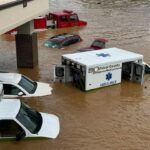
Problem: Flood
Scope: Local, Regional
Impact: Minor, Major (Depending on severity)
Dangers (not limited to): Drowning, Minor Property Damage, Catastrophic Damage, Utilities Interruption
Preps (not limited to): Plan, Insurance, Food and Water Storage, First Aid, Backup Power Source, Inflatable Boat
Floods are one of the most common and devastating natural disasters that can happen anywhere in the world. They can be caused by heavy rainfall, hurricanes, melting snow, or dam failures. Floods can occur in low-lying areas, near bodies of water, and even in regions that have never experienced floods before. In this blog, we will discuss the dangers of a flood and how to prepare for one.
Dangers of a Flood
Floods can cause a lot of damage, both to property and to human life. Here are some of the dangers associated with floods:
- Drowning: Floods can cause rapid and fast-moving water that can sweep away cars, people, and even buildings. The water can quickly rise to dangerous levels, and the force of the water can be overwhelming, making it difficult for people to swim to safety.
- Property damage: Floods can cause extensive property damage, including damage to homes, businesses, roads, and infrastructure. The water can damage buildings, furniture, and appliances, as well as electrical and plumbing systems.
- Health hazards: Floodwater can be contaminated with sewage, chemicals, and other pollutants, which can pose health risks to people and animals. Exposure to floodwater can lead to illnesses such as diarrhea, skin rashes, and infections.
- Displacement: Floods can force people to evacuate their homes and seek shelter elsewhere. This can be a traumatic experience, especially for those who have to leave behind their belongings, pets, and other cherished possessions.
Preparing for a Flood
Being prepared for a flood can help minimize the risks and damages associated with this natural disaster. Here are some steps you can take to prepare for a flood:
- Create an emergency plan: Develop an emergency plan for your family and make sure everyone knows what to do in case of a flood. Identify the safest areas in your home, and have an evacuation plan in place in case you need to leave.
- Build an emergency kit: Put together an emergency kit that includes essential items such as food, water, clothing, medications, first-aid supplies, flashlights, and batteries. Keep the kit in a waterproof container, and make sure it is easily accessible.
- Stay informed: Stay informed about the weather conditions in your area and any flood warnings or advisories. Monitor local news and weather reports, and sign up for emergency alerts.
- Protect your property: Install flood barriers, sandbags, and other protective measures to prevent floodwater from entering your home. Move valuables and electronics to higher ground, and turn off all electrical and gas appliances.
- Evacuate when necessary: If your local authorities issue an evacuation order, follow it immediately. Do not try to wait out the flood, as it can be extremely dangerous.

Flood Emergency Kit
A flood emergency kit should include essential items that can help individuals survive during and after a flood. The following is a list of items that should be included in a flood emergency kit:
- Water: Store at least one gallon of water per person per day for at least three days.
- Non-perishable food: Include enough food to last for at least three days. Choose foods that are easy to store and do not require cooking or refrigeration, such as canned foods, protein bars, and dry goods.
- First aid kit: A basic first aid kit should include items such as bandages, antiseptic wipes, pain relievers, and any necessary prescription medications.
- Personal hygiene items: Include items such as soap, shampoo, toothbrush, toothpaste, and hand sanitizer.
- Flashlights and extra batteries: Make sure to have a flashlight and extra batteries on hand in case of power outages.
- Portable radio: Include a portable, battery-operated or hand-cranked radio to stay informed of weather and emergency updates.
- Emergency cash: Keep a small amount of emergency cash on hand in case ATMs and credit card machines are not operational.
- Important documents: Keep copies of important documents such as passports, insurance policies, and identification in a waterproof container.
- Whistle: A whistle can be used to signal for help in case of an emergency.
- Blankets and warm clothing: Include warm clothing and blankets in case of cold weather or exposure.
- Tools: Include basic tools such as pliers, wrenches, and a multi-purpose knife.
- Inflatable Boat: This one is an extra item that many people don’t have or even think of. If the dam breaks or the levees fail, you could be underwater. Avoid walking through unknown water by loading your women, children, elderly into a lightweight boat that you can inflate without electricity.
It is important to regularly check and update the contents of a flood emergency kit to ensure that all items are up-to-date and in good condition.
In conclusion, floods can be incredibly dangerous and destructive natural disasters that can happen at any time. However, by being prepared and taking the necessary precautions, you can protect yourself, your family, and your property from the risks associated with floods. Create an emergency plan, build an emergency kit, stay informed, protect your property, and evacuate when necessary. By doing so, you can help ensure your safety and well-being during a flood.
It is our mission to educate, equip, and empower ordinary civilians to understand, prepare for, and survive any emergency they face. We cannot rely on the government to take care of us. We must take it upon ourselves to provide for and protect ourselves and our families.
Note: I am an affiliate with Amazon and may receive a commission from products purchased from Amazon. This helps me continue to put out emergency preparedness information for you.










